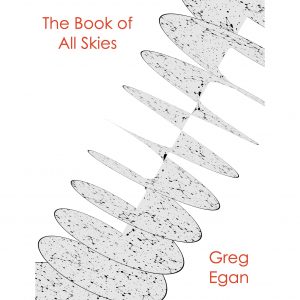Russell Letson Reviews The Book of All Skies by Greg Egan
 The Book of All Skies, Greg Egan (Greg Egan 978-1-922240-38-5, $12.99, 236 pp, tp) September 2021.
The Book of All Skies, Greg Egan (Greg Egan 978-1-922240-38-5, $12.99, 236 pp, tp) September 2021.
Speaking of skies – when Greg Egan leaves our familiar cosmological or geometrical framework, he really leaves it, as he does in The Book of All Skies, which is set on a planet that has been sliced up like a spiral-carved ham by structures called Hoops. (At least that’s what I get from the cover illustration.) That leads me to this initial disclaimer or confession: There are places that Egan’s work goes where I’m too innumerate to keep up, so I just trust that he is getting the strange math or physics or cosmology right and follow the story’s path, whether or not I can completely understand the explanations he supplies in the text or, in considerable detail, on his website. (In this case, see “Gravity in Multiply Connected Space”)
The Book of All Skies actually starts out not-all-that-strange before it gets quite strange – and then manages to make the strange seem normal. It finally strikes me as less a story about strangeness than a familiar Egan story that happens to be set in a very strange place. To museum conservator Cordelia (Del), the ancient book of the novel’s title “had always seemed like a mirage,” and she is drawn not only to the legendary, thousand-generation-old object, but to the questions it might answer about her world and its history: How did the long-vanished Tollean people manage to find a way out of their resource-poor environment to the “Bounteous Lands” and why has no one since managed to follow them? But before Del can start her restoration, the book is stolen, and she sets off in pursuit of the thief, and that is where the topological strangeness of this world starts to be unfolded, as Del travels through several of the Hoops that divide the world into contiguous sections, each with its distinct sky – until one gets to a “nub,” beyond which there is an impassible void. Eventually, Del’s pursuit of the book develops into a resolve to “deduce the coveted secret supposedly contained within its pages,” which leads her to join an expedition that intends to go beyond the nub and find the Bounteous Lands. The project involves complicated calculations, eye-crossing engineering, and a long, slogging journey, followed by a willingness to leap into the unknown – literally.
Del’s travels eventually provide answers to crucial questions: Why would anyone want to steal the Book? What happened to the vanished Tolleans and their emigration route? How did the world get divided by the Hoops in the first place? But what I find as interesting as these puzzles or puzzling out the topological setting are the people and polities that Del and her travel companion, the brave and ingenious but often grumpy Imogen, encounter in their journey. Beyond the nub, they find more resource-rich and technologically-advanced societies, and they see what it can mean to live in a Bounteous Land, a place that is materially and (to them, stranger) socially beyond scarcity. At the far end of their expedition, Del and Imogen wonder why everyone has been so generous to a pair of moneyless wanderers, and they try the patience of one of their hosts with their questions:
“If we didn’t live with you, how would we get food?”
“From the food stalls,” he replied.
“Do we need to give something to the people at the food stalls?”
“No.”
Imogen interjected, “But what if they don’t have enough food to give us?”
“Someone will grow more food.” “Why?” Imogen demanded.
“Because there wasn’t enough,” Halem replied.
In a similar exchange about the possibility of fighting over scarce resources, they are told, “No one ever lets it come to that” and “[W]e seem to have become more skilled at avoiding scarcity than we are at fighting over scraps. Whether you count that as a weakness or a form of resilience is up to you.”
In addition to such mild social comedy, the book is filled with science-fictional details that are certainly extensions of the larger-scale world-building – for example, the otherwise-human characters have various physiological traits that are depicted but not emphasized and are eventually accounted almost in passing. I suppose it’s the mark of the English-lit nerd in me, but the (non-SF) puzzle I return to is why all but one of the characters in the first chapters bear names from Shakespeare plays. Am I missing an Easter egg?
So I see two Egans here, one a deviser of arcane, brain-twisting topological-mathematical schemes, and one a meticulous investigator of ethical, social, and psychological questions. Both are systematic, relentless, and fearless in these pursuits. And, at the risk of waxing allegorical, I find that Egan’s stories about people separated by strange geometries or cosmic rule-sets are starting to resonate in ways that have more to do with our current social and political anxieties than with abstract exercises in topology or physics. Here, as in Phoresis and Dispersion, we have people struggling to understand and deal with their world’s “nature” – in this case, its topology – and cooperating in order to accomplish their goals. And the solutions emerge from reason, rigor, persistence, courage, and trust rather than competition or violence. Moral drama replaces melodrama. It’s not only the science that’s hard in these stories.
Russell Letson, Contributing Editor, is a not-quite-retired freelance writer living in St. Cloud MN. He has been loitering around the SF world since childhood and been writing about it since his long-ago grad school days. In between, he published a good bit of business-technology and music journalism. He is still working on a book about Hawaiian slack key guitar.
This review and more like it in the December 2021 issue of Locus.
 While you are here, please take a moment to support Locus with a one-time or recurring donation. We rely on reader donations to keep the magazine and site going, and would like to keep the site paywall free, but WE NEED YOUR FINANCIAL SUPPORT to continue quality coverage of the science fiction and fantasy field.
While you are here, please take a moment to support Locus with a one-time or recurring donation. We rely on reader donations to keep the magazine and site going, and would like to keep the site paywall free, but WE NEED YOUR FINANCIAL SUPPORT to continue quality coverage of the science fiction and fantasy field.
©Locus Magazine. Copyrighted material may not be republished without permission of LSFF.




